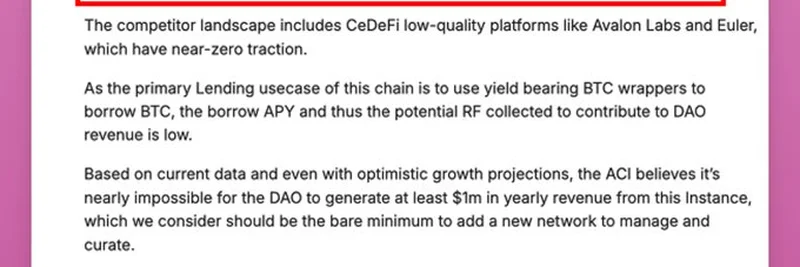Hey there, crypto enthusiasts! If you’ve been keeping an eye on the decentralized finance (DeFi) space, you’ve probably heard about the latest shake-up involving Aave DAO. On August 1, 2025, a tweet from Ignas | DeFi dropped a bombshell: Aave DAO is pulling back from new Layer 2 (L2) deployments due to mounting losses and a phenomenon dubbed "L2 fatigue." Let’s break it down and see what this means for the future of DeFi.
Why Aave DAO Is Hitting the Brakes
Aave DAO, a major player in the lending and borrowing ecosystem, has been spreading its wings across 16 chains. However, recent data shows that some of these new networks—like Soneium, Celo, Linea, zkSync, and Scroll—are operating at a loss. This revelation came from a governance proposal update shared by MarcZeller, highlighting that the DAO has been "too lenient" with its expansion strategy.
The primary issue? Low revenue. Many of these L2s, including the proposed Bob BTC, rely heavily on yield-bearing BTC wrappers for lending. But with low borrow Annual Percentage Yield (APY) and minimal revenue from Risk Factors (RF), the financial returns just aren’t cutting it. Even with optimistic growth projections, the Aave Community Initiative (ACI) believes it’s nearly impossible for the DAO to generate at least $1 million in yearly revenue from these instances—a benchmark they consider the bare minimum for new network additions.
The Rise of L2 Fatigue
This decision aligns with a broader trend in the crypto world: L2 saturation. As explained in the thread, the competitor landscape is crowded with low-quality platforms like Avalon Labs and Euler, which are struggling to gain traction. The tweet from Ignas also references a Curve DAO forum proposal suggesting a halt to all future or ongoing L2 developments. Why? These networks are generating a measly $1.5k USD in fees while draining significant time and resources from development teams.
Alexander Sleuth and IRAJ Bless Maxi chimed in, pointing out the "L2 fatigue" hitting hard. If an L2 doesn’t bring something unique to the table, it’s just burning developer hours and gas rebates without meaningful returns. This sentiment echoes the challenges faced by Ethereum and other Layer 1 blockchains as they scale, where L2s are meant to offload transaction processing but are now oversaturated.
The Risks of Yield Wrappers
Another red flag raised in the proposal is the use of yield wrappers. These tools, while useful as collateral, introduce bad debt risk that projected revenue can’t justify. For Aave DAO, this is a critical concern, as maintaining a stable lending platform hinges on managing risk effectively. With sunk costs already invested, the ACI recommends shifting focus to other initiatives rather than doubling down on unprofitable L2s.
What This Means for DeFi and Meme Tokens
So, what’s the takeaway for the DeFi community—and even the meme token crowd at Meme Insider? This move signals a maturing market where efficiency trumps blind expansion. For blockchain practitioners, it’s a reminder to prioritize high-value networks and innovative solutions over chasing every new L2 opportunity. As L2 fatigue sets in, we might see a shift toward more specialized use cases, potentially influencing the next wave of meme token projects that leverage DeFi infrastructure.
Aave DAO’s decision to vote against further L2 deployments could also inspire other DAOs to rethink their strategies. With the crypto space evolving rapidly in 2025, staying adaptable is key. Whether you’re a DeFi newbie or a seasoned trader, keeping an eye on these developments will help you navigate the shifting landscape.
What do you think about this L2 pullback? Drop your thoughts in the comments, and stay tuned to Meme Insider for more updates on the latest crypto trends!


